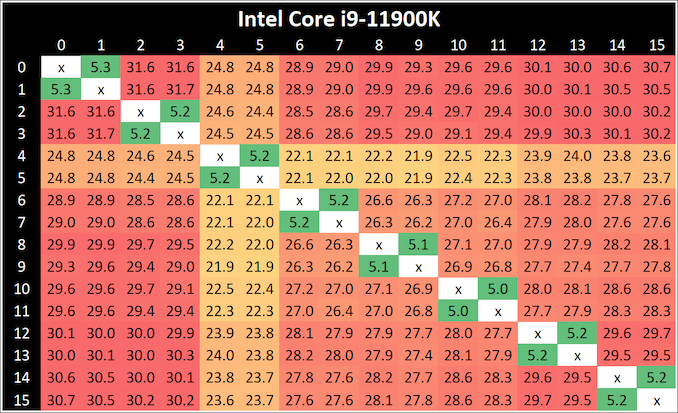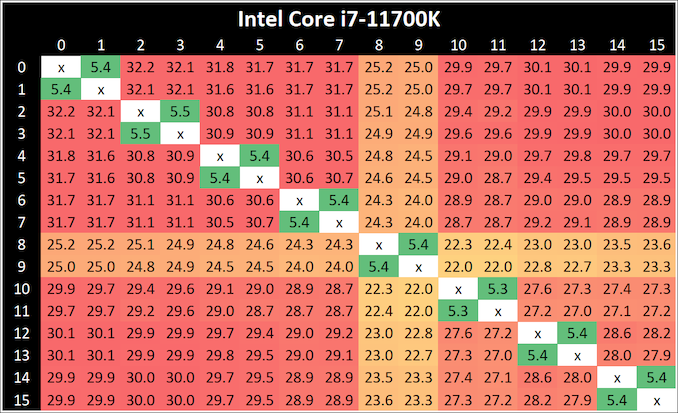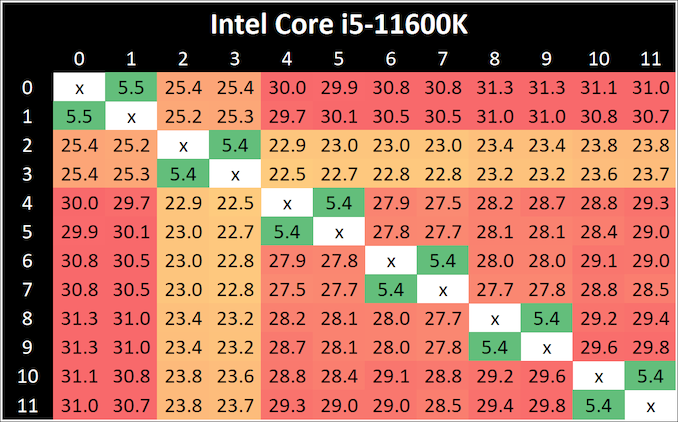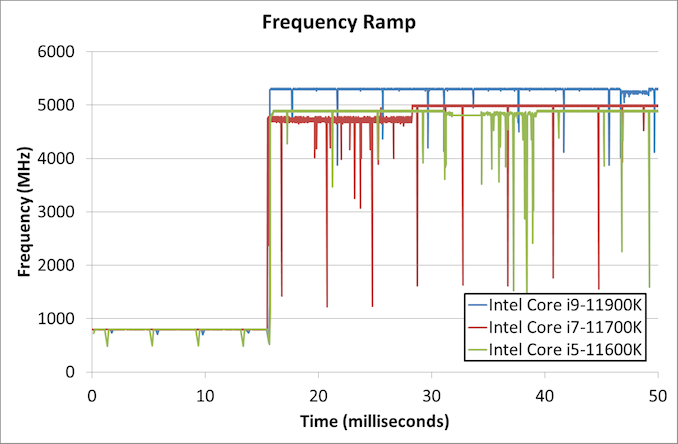Intel Rocket Lake (14nm) Review: Core i9-11900K, Core i7-11700K, and Core i5-11600K
by Dr. Ian Cutress on March 30, 2021 10:03 AM EST- Posted in
- CPUs
- Intel
- LGA1200
- 11th Gen
- Rocket Lake
- Z590
- B560
- Core i9-11900K
CPU Tests: Microbenchmarks
Core-to-Core Latency
As the core count of modern CPUs is growing, we are reaching a time when the time to access each core from a different core is no longer a constant. Even before the advent of heterogeneous SoC designs, processors built on large rings or meshes can have different latencies to access the nearest core compared to the furthest core. This rings true especially in multi-socket server environments.
But modern CPUs, even desktop and consumer CPUs, can have variable access latency to get to another core. For example, in the first generation Threadripper CPUs, we had four chips on the package, each with 8 threads, and each with a different core-to-core latency depending on if it was on-die or off-die. This gets more complex with products like Lakefield, which has two different communication buses depending on which core is talking to which.
If you are a regular reader of AnandTech’s CPU reviews, you will recognize our Core-to-Core latency test. It’s a great way to show exactly how groups of cores are laid out on the silicon. This is a custom in-house test built by Andrei, and we know there are competing tests out there, but we feel ours is the most accurate to how quick an access between two cores can happen.
All three CPUs exhibit the same behaviour - one core seems to be given high priority, while the rest are not.
Frequency Ramping
Both AMD and Intel over the past few years have introduced features to their processors that speed up the time from when a CPU moves from idle into a high powered state. The effect of this means that users can get peak performance quicker, but the biggest knock-on effect for this is with battery life in mobile devices, especially if a system can turbo up quick and turbo down quick, ensuring that it stays in the lowest and most efficient power state for as long as possible.
Intel’s technology is called SpeedShift, although SpeedShift was not enabled until Skylake.
One of the issues though with this technology is that sometimes the adjustments in frequency can be so fast, software cannot detect them. If the frequency is changing on the order of microseconds, but your software is only probing frequency in milliseconds (or seconds), then quick changes will be missed. Not only that, as an observer probing the frequency, you could be affecting the actual turbo performance. When the CPU is changing frequency, it essentially has to pause all compute while it aligns the frequency rate of the whole core.
We wrote an extensive review analysis piece on this, called ‘Reaching for Turbo: Aligning Perception with AMD’s Frequency Metrics’, due to an issue where users were not observing the peak turbo speeds for AMD’s processors.
We got around the issue by making the frequency probing the workload causing the turbo. The software is able to detect frequency adjustments on a microsecond scale, so we can see how well a system can get to those boost frequencies. Our Frequency Ramp tool has already been in use in a number of reviews.
From an idle frequency of 800 MHz, It takes ~16 ms for Intel to boost to the top frequency for both the i9 and the i5. The i7 was most of the way there, but took an addition 10 ms or so.














279 Comments
View All Comments
29a - Tuesday, March 30, 2021 - link
No iGPU tests?Alistair - Tuesday, March 30, 2021 - link
Quote from Ars Technia: Rocket Lake-S gets a small but noticeable upgrade to its integrated graphics performance—the 10th-generation Core CPU's UHD 630 graphics gets bumped up to UHD 750. While it is an improvement, it's nothing to write home about—if you were hoping for an equivalent to Intel's Iris Xe graphics in Tiger Lake laptop CPUs (or AMD's Vega 11 in desktop APUs) you'll be sorely disappointed.A modest GeForce GTX 1060 is good for a Time Spy Graphics score of roughly 4,000. Intel's flagship i7-1185G7 laptop CPU manages nearly half that at 1572, with AMD's Vega 11 lagging noticeably behind at 1226. Rocket Lake-S' UHD 750 comes in at a yawn-inducing 592—a little less than half the performance of Vega 11 and a little more than one-third the performance of Iris Xe.
KaarlisK - Tuesday, March 30, 2021 - link
Also, notice that i5 11400 has UHD Graphics 730, which has less EUs (24 not 32). So with the cheapest i5 (10400->11400) there may actually be a regression in iGPU performance.Hifihedgehog - Tuesday, March 30, 2021 - link
Sounds like even on as advanced a process as 14nm+++++++++++++++++++++++++++++++++++++ that yields aren't exactly that spectacular then for this backport.tipoo - Tuesday, March 30, 2021 - link
Well density definitely isn't.III-V - Tuesday, March 30, 2021 - link
Why in the world would you come to that conclusion?firewolfsm - Wednesday, March 31, 2021 - link
Because Intel generally hasn't had to cut the IGP for i5 models in the past. The cut indicates they're producing chips with bad EUs.KaarlisK - Wednesday, March 31, 2021 - link
In the past, they could offload half-funcioning GPUs to Pentiums and Celerons. There are no Rocket Lake i3s even...Alistair - Tuesday, March 30, 2021 - link
I was bored, so I went and bought the i5-11500 just to test Intel Xe haha. I'll post benchmarks later.Alistair - Tuesday, March 30, 2021 - link
Ok it gets ~40 fps in Overwatch at 1080p, and ~100fps at 50 percent of 1080p (scaling at higher resolutions is bad with DDR memory). Ouch. Not great. Usable, but not great. This is with very fast memory. DDR4 3600 C16.Now I'm going to try Runeterra.